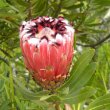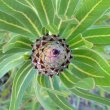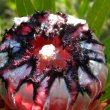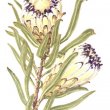Protea neriifolia
| Botanical Name | Protea neriifolia |
|||||||||||
| Family | Proteaceae - The Protea family
|
|||||||||||
| Pronunciation | PROH-tee-uh ner-ee-eye-FOH-lee-uh |
|||||||||||
| Common Name(s) |
English: Blue Sugarbush; Narrow-leaved Sugarbush; Oleander-leaved Sugarbush
Afrikaans: Baardsuikerbos; Baardsuikerkan; Blousuikerbos; Blousuikerkan
|
|||||||||||
| Plant Group |
|
|||||||||||
| Plant Size |
|
|||||||||||
| Position |
|
|||||||||||
| General Information |
|
|||||||||||
| Specific Information | Protea neriifolia, a member of the Bearded Sugarbushes, is one of the easiest proteas to grow. The long, slender leaves look similar to the leaves of the oleander (Nerium oleander), are hard and leathery and can be bright- or dark green in colour. It grows reasonably fast and flowers in its third season. Protea neriifolia has a wider tolerance than most other proteas and can be grown in a climate with wet winters and dry summers, as well as in a climate with dry cold winters and wet summers and can withstand light, but brief frosts. It has a fairly long flowering time which varies according to the area in which it is grown, flowers peaking in the western, winter rainfall areas in autumn, and in spring in the eastern summer rainfall areas of its range. Living for 15 years or more, Protea neriifolia is an excellent plant for the garden, especially as it grows quite well in soil which is slightly alkaline. The large flowers last up to three weeks in water and vary in colour from creamy-green to pink to deep carmine with a fluffy 'beard' of purple-black to pure white hairs. The flowers are pollinated by scarab beetles, protea beetles and many other insects, as well as by birds which are attracted by both the nectar and the insects visiting the flowers. |
|||||||||||
| Ad Break | ||||||||||||
| Flowers | ||||||||||||
| Description | flowerheads are oblong to slightly flared with a collection of flowers in the center, surrounded by large colourful bracts edged with a fluffy 'beard' |
|||||||||||
| Season |
|
|||||||||||
| Colour |
|
|||||||||||
| Growth Rate |
|
|||||||||||
| Plant Uses |
|
|||||||||||
| Distribution and Habitat | from the southern coastal mountain ranges just east of Cape Town in the Western Cape to Port Elizabeth in the Eastern Cape, from sea-level to 1300 m altitude, in sandy soils |
|||||||||||
| Planting Suggestions | Proteas demand very well-drained, nutrient poor soil in a sunny, airy position. They will not grow well in clay soils and will die if their roots are kept wet. If possible plant on a slope or on slightly elevated mound to prevent drainage problems. In the cooler summer rainfall regions try for a north facing slope. Dig a hole twice the width of the container and one and a half times the height. Do not apply artificial fertilizer or fresh manure to the soil mix. Mulch well around the plant but keep the area around the trunk of the plant clear, as the crown of the plant must be able to dry off. Proteas have a dense network of fine roots just below the surface of the soil and no cultivation should take place below them as disturbance will damage the roots and possibly introduce fungal disease, resulting in the death of the plant. The use of a thick mulch of leaf litter and pine bark/needles will feed the plant, keep the soil cool and discourage weeds. In summer rainfall areas water regularly during winter and occasionally in summer if the weather is dry. Always water in the early morning, preferably before the sun has fully risen. Stems bearing old flower heads should be cut back to encourage the development of new shoots and long stems.
If growing Protea from seed, see this blog: http://kumbulanursery.co.za/blog/obtaining-and-growing-protea-seeds I am in the process of writing an article about growing and care of Protea and will include the link shortly. For the moment however, go to http://finebushpeople.co.za for more details about planting and care. Most Protea losses are due to fungal diseases and by the time you notice the plant is in stress, it is usually too late to do anything to save the plant. The best control is preventative: water plants early in the morning; keep soil surface cool by mulching; do not over-fertilise, remove diseased plants immediately; do not over water in summer and never disturb the roots. Burn any diseased material. Older plants can get woody and unattractive, with quite short side shoots, so to keep a plant in shape and encourage the development of new shoots and long stems, the stems bearing old flower heads should be cut back. |
|||||||||||
| Medicinal Uses | No data found. |
|||||||||||
| Ad Break | ||||||||||||










Comments
The discs needed to start planting proteas
Hi, do you perhaps sell the smoke discs I need to start planting my protea seeds?
Smoke Primer discs
Hi Chenee
You can get them from the protea seed supplier at http://finebushpeople.co.za/.
Kind regards
Lorraine
Growing Protea in pots
Great info - Thanks.
I have managed to get my Protea neriifolia to flower this year here in the UK. It is in a pot. I put it in the Greenhouse over winter and wrap it in fleece. I have been trying to get protea to flower here for 7 years , this is my first successes. The plant is 3 years old and bout 1.2M tall. see photo attached . I am not sure if I should cut the flower and display it or leave it on the plant.
Protea neriifolia in the UK
Hi Peter
Apologies for my tardy reply.
The flower is just lovely. You must feel like a proud papa. My mom always told me she cut her flowers off as they lasted longer in a vase than on the plant, that it was good for the plant as it encouraged branching and increased flowering for the next year, and the plant didn't need to use energy to form seeds.
All the best with your proteas and I hope you get more flowers - without having to wait for another 7 years.
Kind regards
Lorraine
Growing Protea in pots
Thanks for the reply. I cut the protes yesterday and it is now in a vase. See attachment. it is fully open now.
I seem to remember seeing somewhere that if you hang the flowers upside down they will dry with close to the original colour and last for years.
Ppeter
Drying proteas
Such a perfect flower. I have also heard something like that, but then I have heard it for a number of other plants as well. I suspect it may be a bit of an old-wive's tale, but it may be worth googling if you want to try it. I am sure there is more to it than just hanging it upside down.
Discuss this plant
Share knowledge, ask a question or give an experience.